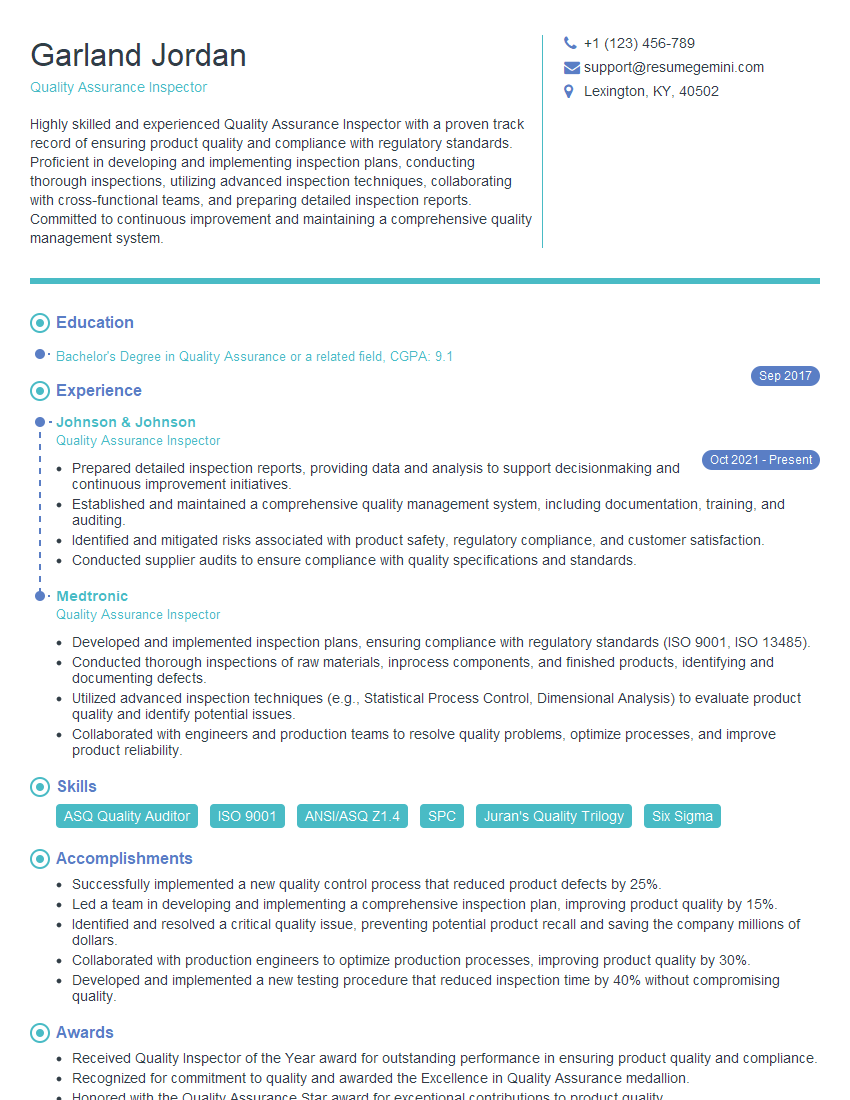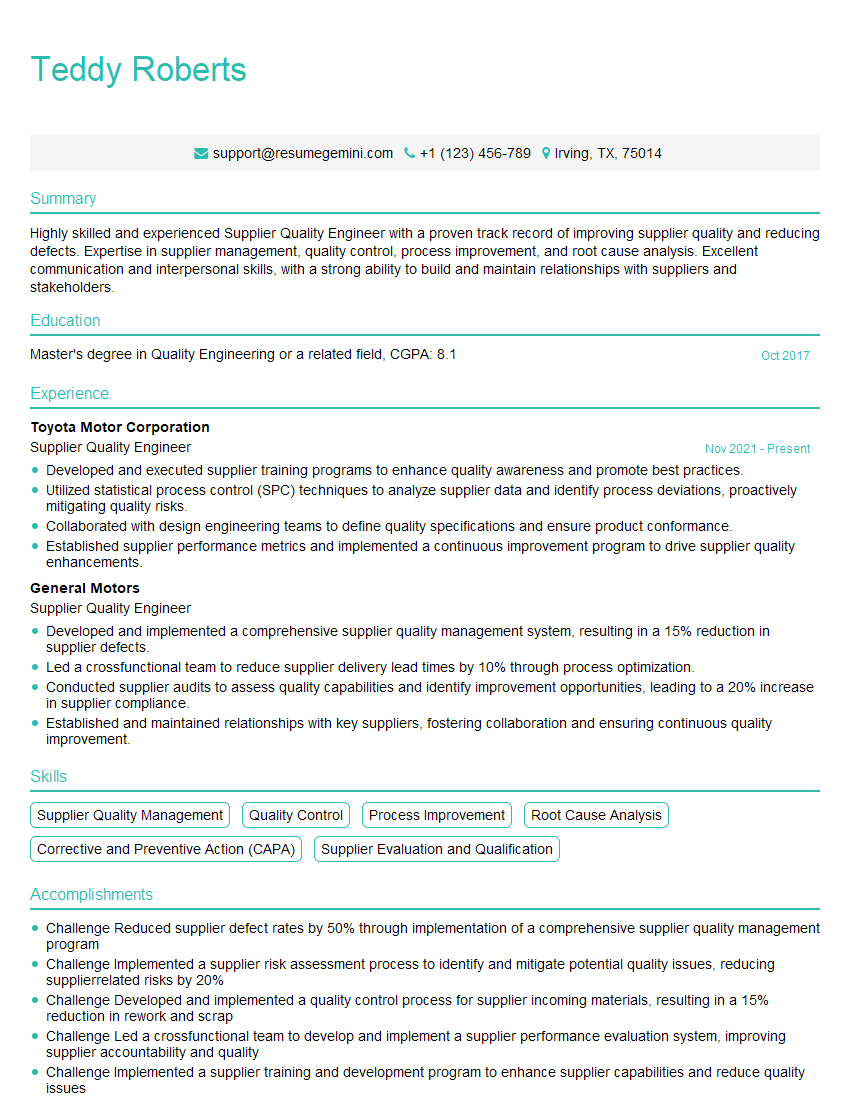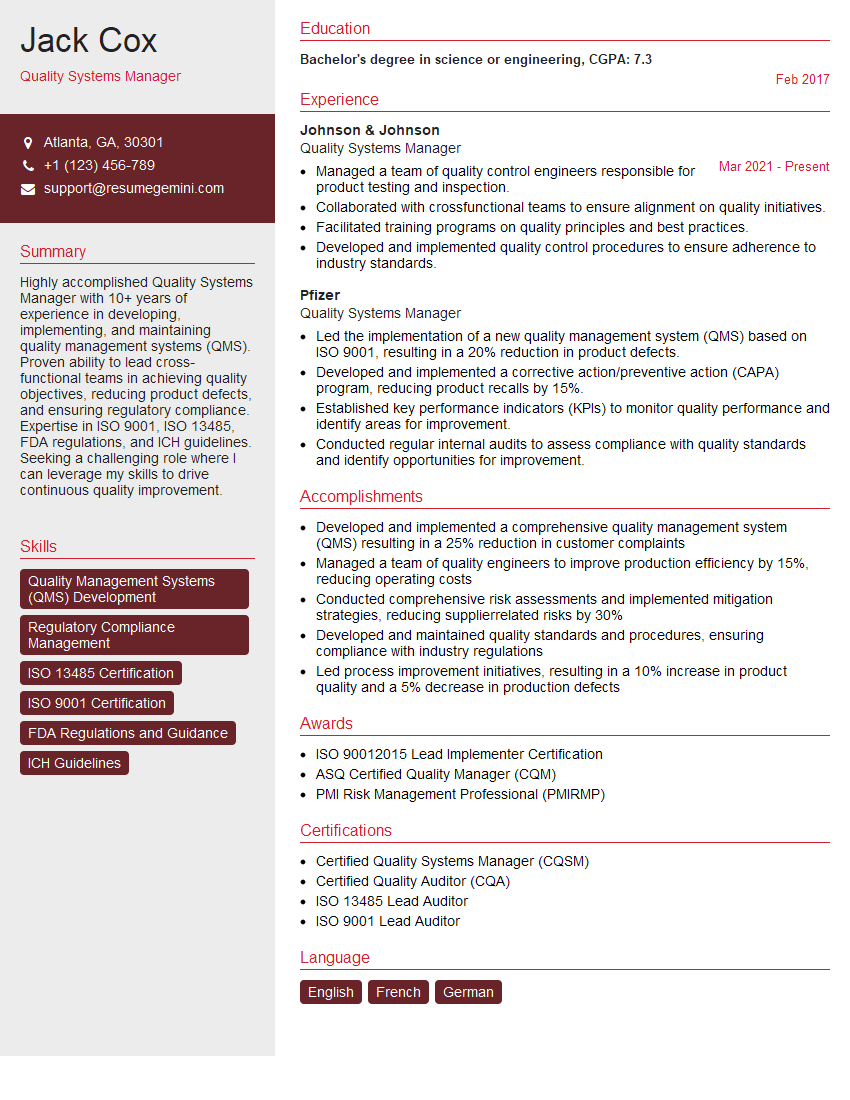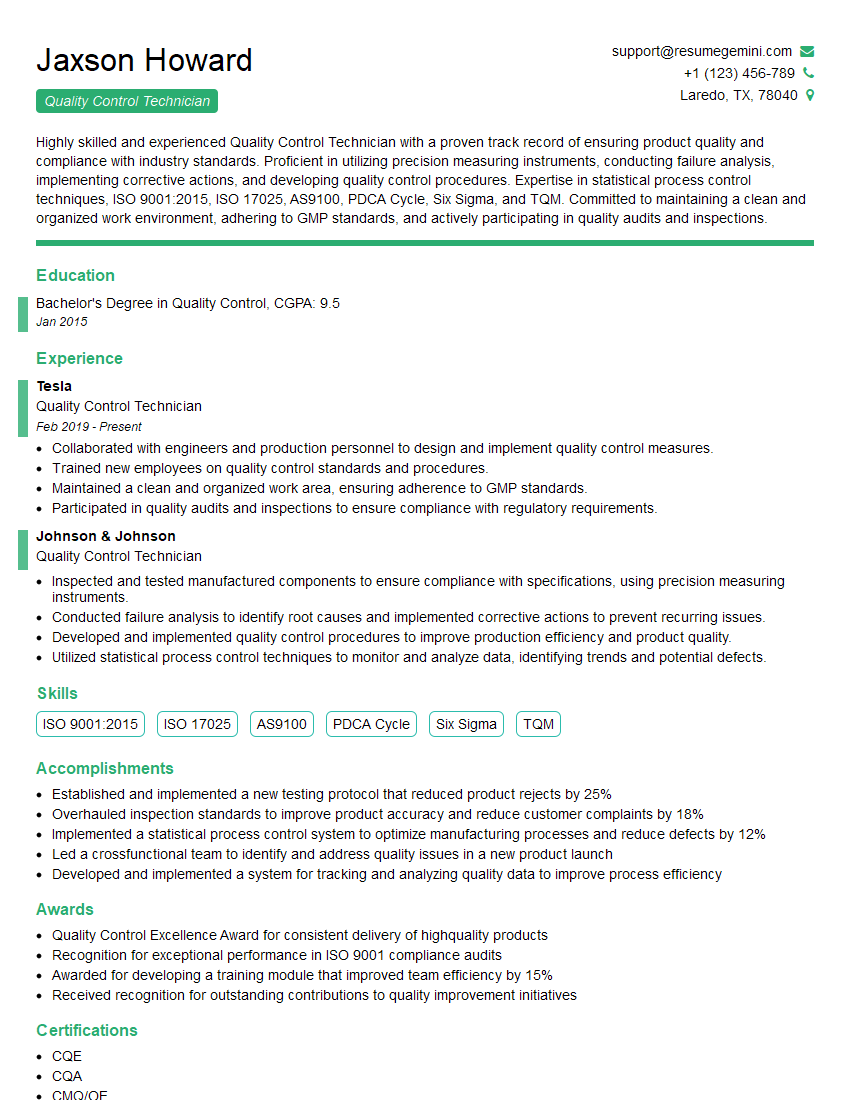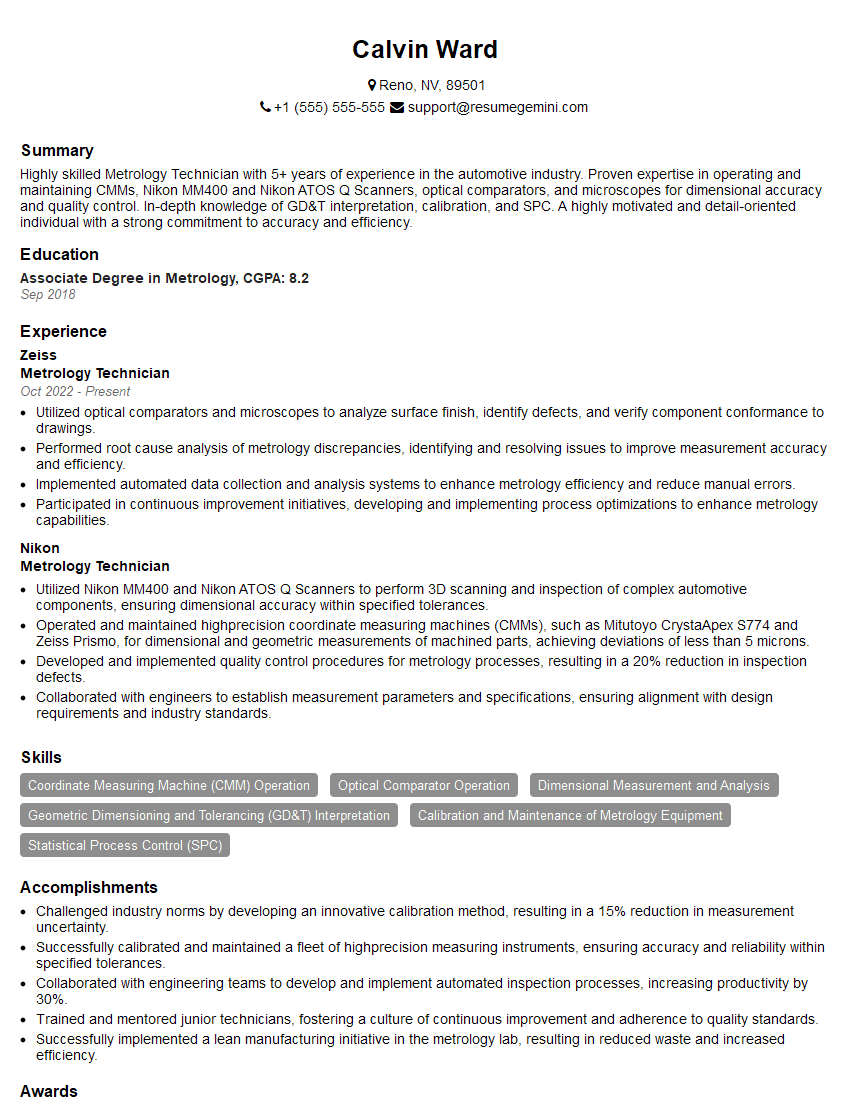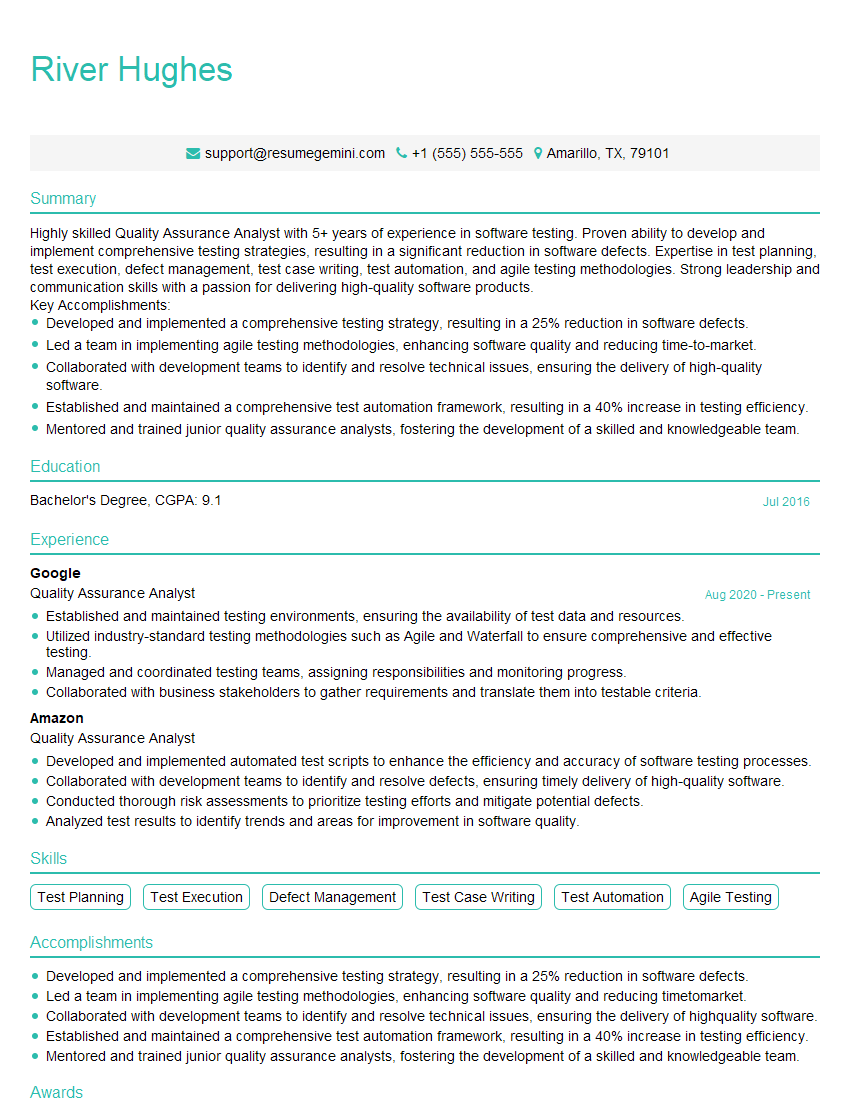Interviews are opportunities to demonstrate your expertise, and this guide is here to help you shine. Explore the essential Aerospace Quality Assurance (ASQA) interview questions that employers frequently ask, paired with strategies for crafting responses that set you apart from the competition.
Questions Asked in Aerospace Quality Assurance (ASQA) Interview
Q 1. Explain the importance of AS9100 in aerospace manufacturing.
AS9100 is the internationally recognized quality management systems standard specific to the aerospace industry. It’s based on ISO 9001 but adds requirements crucial for the demanding safety and reliability standards of aerospace manufacturing. Think of it as the gold standard, ensuring consistent product quality, safety, and regulatory compliance. Its importance stems from the high stakes involved – a faulty part in an aircraft can have catastrophic consequences.
- Enhanced Customer Confidence: AS9100 certification demonstrates a commitment to quality, building trust with customers and partners.
- Reduced Risk: Proactive quality management systems significantly reduce the likelihood of defects and associated costs, such as recalls and legal liabilities.
- Improved Efficiency: The structured approach promotes efficiency through optimized processes and waste reduction.
- Regulatory Compliance: AS9100 compliance helps organizations meet various regulatory requirements worldwide, preventing potential penalties.
- Supply Chain Integration: It facilitates seamless integration within the aerospace supply chain, ensuring consistent quality across all tiers.
For example, a company producing aircraft fasteners would need AS9100 certification to demonstrate to major aircraft manufacturers that its parts meet the rigorous quality standards required for safe flight operations. Failure to meet these standards could lead to contract termination or even legal action.
Q 2. Describe your experience with conducting internal audits.
I have extensive experience conducting internal audits, both as an auditor and as an auditee. My approach emphasizes a collaborative, improvement-focused methodology, rather than a purely punitive one. I’ve conducted audits across various aerospace manufacturing processes, including machining, assembly, and electronic component manufacturing.
- Planning and Preparation: Thorough review of relevant documentation (e.g., AS9100 manual, process flowcharts, inspection records) before the audit to ensure focus and efficiency.
- Audit Execution: Utilizing a combination of document review, process observations, and interviews to assess compliance and effectiveness. I focus on gathering evidence to support findings, rather than just identifying nonconformities.
- Reporting and Follow-up: Generating concise and well-documented audit reports that clearly outline findings, including evidence and recommendations. I follow up to ensure that corrective actions are implemented effectively and verified.
For instance, during an internal audit of a machining process, I observed inconsistencies in the calibration records of measuring equipment. This led to a recommendation for improved calibration tracking and training for the operators, preventing potential dimensional deviations in the manufactured parts. I would ensure the corrective action, including recalibration and retraining, is documented and verified through a follow-up audit.
Q 3. How do you identify and mitigate potential quality risks?
Identifying and mitigating quality risks is a continuous process. I use a proactive, multi-faceted approach that combines risk assessment tools, process monitoring, and continuous improvement initiatives.
- Risk Assessment: Employing tools like Failure Mode and Effects Analysis (FMEA) to identify potential failure modes and their effects, prioritizing those with the highest potential impact.
- Process Monitoring: Utilizing Statistical Process Control (SPC) to monitor key process parameters and identify deviations from established control limits before they become major issues.
- Data Analysis: Regular review of quality data (e.g., defect rates, customer complaints) to pinpoint trends and underlying causes of quality issues.
- Preventive Measures: Implementing preventive actions based on identified risks, such as process improvements, equipment upgrades, or additional training.
For example, if the analysis shows a high defect rate linked to a specific machine, the risk mitigation strategy might involve scheduling machine maintenance, investing in a newer model, or retraining the operators on proper machine operation. This proactive approach prevents the defects from impacting final products.
Q 4. Explain your understanding of Failure Mode and Effects Analysis (FMEA).
Failure Mode and Effects Analysis (FMEA) is a systematic, proactive method for identifying potential failure modes in a system or process and assessing their severity, occurrence, and detectability. The goal is to prioritize risks and implement actions to mitigate the most critical ones. It’s like a preemptive strike against potential problems.
The FMEA process typically involves a team reviewing each step of a process or system to identify potential failure modes, their causes, effects, severity, occurrence, and detection. A risk priority number (RPN) is calculated (Severity x Occurrence x Detection) to prioritize actions.
- Severity: How serious is the effect of the failure?
- Occurrence: How likely is the failure to occur?
- Detection: How likely is the failure to be detected before it reaches the customer?
A high RPN indicates a high-risk failure mode requiring immediate attention. The team then develops and implements actions to reduce the RPN, often focusing on reducing the severity or occurrence of the failure. A post-implementation review confirms the effectiveness of the actions.
For example, in the manufacturing of a critical aircraft component, an FMEA might identify a potential failure mode of a crack forming due to improper material handling. By implementing improved handling procedures and increased inspections, the occurrence and severity of this failure can be significantly reduced, decreasing the RPN.
Q 5. What is your experience with Corrective Action Preventive Action (CAPA)?
Corrective Action Preventive Action (CAPA) is a systematic process for addressing both existing quality issues (corrective action) and preventing their recurrence (preventive action). It’s about learning from mistakes and preventing them from happening again. Think of it as a closed-loop system for continuous improvement.
My experience encompasses all stages of the CAPA process:
- Problem Identification and Definition: Clearly defining the nature and scope of the nonconformity, gathering data to understand the root cause.
- Root Cause Analysis: Utilizing various tools like fishbone diagrams, 5 Whys, and Pareto charts to identify the underlying cause of the nonconformity.
- Corrective Action Implementation: Developing and implementing effective actions to address the immediate problem, ensuring that the identified root causes are eliminated.
- Preventive Action Implementation: Developing and implementing measures to prevent the recurrence of similar nonconformities, improving processes to prevent future issues.
- Effectiveness Verification: Monitoring the implemented actions to ensure their effectiveness and verify that the problem has been resolved and will not recur.
For instance, if a batch of parts failed a dimensional inspection, a CAPA would involve investigating the cause (perhaps a machine malfunction or operator error), correcting the immediate problem (reworking or scrapping the faulty parts), and preventing future occurrences (e.g., machine maintenance, operator retraining, process improvement).
Q 6. Describe your experience with Statistical Process Control (SPC).
Statistical Process Control (SPC) is a powerful tool for monitoring and controlling processes to ensure consistent product quality. It uses statistical methods to identify variations in a process and determine whether those variations are due to common (random) causes or special (assignable) causes. Think of it as a process ‘check-up’ using data.
My experience includes implementing and interpreting control charts (e.g., X-bar and R charts, p-charts, c-charts) to monitor key process parameters. I’ve used SPC to:
- Monitor Process Stability: Determining whether a process is in statistical control, indicating predictable and consistent performance.
- Identify Process Variation: Pinpointing sources of variation (common vs. special causes) to implement corrective actions.
- Reduce Process Variability: Implementing process improvements to reduce the overall variation and improve process capability.
- Prevent Defects: Using SPC data to identify and address potential problems before they lead to nonconforming products.
For example, in a manufacturing process involving the assembly of a complex component, we used X-bar and R charts to monitor the assembly time. By identifying a trend of increasing assembly times, we were able to pinpoint the cause (lack of proper training for a new assembly technique) and implement corrective actions (retraining) to stabilize the process and reduce variability.
Q 7. How do you manage nonconforming material?
Managing nonconforming material requires a structured approach to ensure that defective parts do not enter the supply chain and cause further problems. This involves careful identification, segregation, evaluation, and disposition of the nonconforming material. It’s crucial to follow a documented procedure to maintain traceability and compliance.
My process typically involves:
- Identification and Segregation: Clearly marking and isolating nonconforming material to prevent its accidental use.
- Investigation and Root Cause Analysis: Determining the root cause of the nonconformity to prevent recurrence, often using the CAPA process.
- Evaluation: Assessing the potential impact of the nonconformity and deciding whether the material can be reworked, repaired, scrapped, or used for other purposes.
- Disposition: Documenting the disposition of the nonconforming material (e.g., rework, scrap, concession). Maintaining clear records of the entire process is essential.
- Control and Traceability: Maintaining a system to track nonconforming material throughout the process and ensure accountability.
For example, if a batch of parts failed a critical dimension test, I would immediately segregate them, investigate the root cause, and determine whether they could be reworked, potentially with a concession, or scrapped. The entire process would be documented meticulously, ensuring traceability and compliance with AS9100 requirements.
Q 8. Explain your understanding of root cause analysis techniques.
Root cause analysis (RCA) is a systematic approach to identifying the underlying causes of problems, not just the symptoms. It’s crucial in ASQA because addressing only the surface issue often leads to recurrence. Several techniques exist, each with strengths and weaknesses:
5 Whys: A simple, iterative questioning method. You repeatedly ask ‘Why?’ until you reach the root cause. For example, if a part fails: Why did it fail? (Material defect). Why was the material defective? (Supplier error). Why did the supplier err? (Lack of training). Why was training lacking? (Insufficient budget). Why was the budget insufficient? (Poor project planning). The root cause here is poor project planning.
Fishbone Diagram (Ishikawa): A visual tool that categorizes potential causes (e.g., Manpower, Method, Machine, Material, Measurement, Environment) into branches stemming from the problem statement. It’s excellent for brainstorming and collaborative problem-solving.
Fault Tree Analysis (FTA): A top-down, deductive approach that graphically depicts how various lower-level events can combine to cause a top-level undesired event. It’s used for complex systems.
Pareto Analysis: Focuses on the ‘vital few’ causes contributing to the majority of problems. By addressing these key factors first, you can achieve significant improvement with focused effort.
In ASQA, selecting the appropriate RCA technique depends on the complexity of the issue, the available data, and time constraints. I’ve used all of these methods extensively, often combining them for a more comprehensive understanding.
Q 9. How do you ensure compliance with regulatory requirements?
Ensuring compliance with regulatory requirements like FAA regulations, AS9100, and other industry-specific standards is paramount in ASQA. My approach is multi-faceted:
Stay Updated: I actively monitor changes and updates to relevant regulations and standards through industry publications, regulatory agency websites, and professional development courses.
Implement a robust Quality Management System (QMS): This includes documented processes, procedures, work instructions, and internal audits to ensure all activities align with regulatory requirements. The QMS becomes the living document that guides our compliance.
Regular Audits: Internal audits are conducted regularly to identify non-conformances and areas for improvement. External audits by certification bodies ensure compliance with the standards and offer a third-party perspective.
Corrective and Preventive Actions (CAPA): When non-conformances are found, a formal CAPA process is implemented to address the root cause and prevent recurrence. This process is documented, tracked, and verified.
Training and Awareness: Ensuring that all personnel involved in the aerospace manufacturing process receive adequate training on relevant regulations and procedures is crucial. This is a continuous process.
Compliance isn’t a one-time event; it’s an ongoing commitment requiring vigilance and a proactive approach.
Q 10. Describe your experience with supplier quality management.
Supplier Quality Management (SQM) is critical for maintaining the overall quality of the aerospace product. My experience involves:
Supplier Selection: Rigorous selection processes involving pre-qualification audits, capability assessments, and review of supplier quality records. This includes validating the supplier’s quality management system and their ability to meet our requirements.
Supplier Monitoring: Ongoing monitoring of supplier performance through regular audits, performance reviews, and analyzing key performance indicators (KPIs). This ensures they continue to meet our requirements.
Collaboration and Communication: Open and frequent communication with suppliers to address potential issues proactively. This includes sharing data, best practices, and expectations.
Corrective Actions: If a supplier fails to meet our quality requirements, a formal process is followed to address the issue, including corrective actions, improvement plans, and potential corrective actions.
Continuous Improvement: Working collaboratively with suppliers to improve their processes and overall quality performance, contributing to continuous improvement of the entire supply chain.
One memorable example involved a supplier whose machining process was producing inconsistent tolerances. Through a collaborative approach involving on-site support and process optimization, we improved their process significantly, resulting in reduced scrap and improved product quality. Building strong relationships with our suppliers is as critical as the technical aspects of SQM.
Q 11. How do you handle customer complaints related to quality issues?
Handling customer complaints regarding quality issues demands a structured and professional approach:
Immediate Acknowledgement: Promptly acknowledge the complaint and assure the customer that their issue is being addressed. This sets the tone for a positive resolution.
Thorough Investigation: A systematic investigation is conducted to gather all necessary data, including examining the affected product, reviewing manufacturing records, and interviewing relevant personnel.
Root Cause Analysis: Employ appropriate RCA techniques to determine the underlying cause of the problem.
Corrective Action: Develop and implement effective corrective actions to prevent similar issues from recurring. This includes addressing both immediate concerns and root causes.
Communication and Resolution: Keep the customer informed of the progress of the investigation and corrective actions. Work towards a mutually acceptable solution, which may involve repair, replacement, or compensation.
Documentation: Maintain detailed records of the entire complaint handling process, from initial contact to final resolution. This documentation serves as evidence of our responsiveness and corrective actions.
Addressing customer complaints efficiently and effectively not only maintains customer satisfaction but also protects the company’s reputation and provides valuable data for continuous improvement.
Q 12. What is your experience with process improvement initiatives?
My experience with process improvement initiatives in ASQA is extensive. I’ve been involved in projects utilizing various methodologies, including:
Lean Manufacturing: Implementing lean principles to eliminate waste, improve efficiency, and reduce lead times. This includes value stream mapping, 5S methodology, and Kaizen events.
Six Sigma: Applying Six Sigma methodologies (DMAIC or DMADV) to systematically reduce process variation and improve quality. I have led several projects focused on reducing defect rates and improving process capabilities.
Statistical Process Control (SPC): Using SPC charts (e.g., control charts) to monitor process performance, identify trends, and detect potential problems before they escalate.
Design of Experiments (DOE): Employing DOE to optimize processes and reduce variability through systematic experimentation. This involves designing experiments to identify the key factors impacting the process.
In one project, we utilized Six Sigma DMAIC to reduce the defect rate in a critical assembly process by 75%. This involved identifying the root causes through data analysis, implementing process changes, and effectively managing the project’s scope and objectives. Continuous improvement is an ongoing commitment—it’s never truly ‘finished’.
Q 13. Explain your understanding of quality metrics and key performance indicators (KPIs).
Quality metrics and Key Performance Indicators (KPIs) provide quantifiable measures of quality performance. In ASQA, these are crucial for monitoring progress, identifying areas for improvement, and demonstrating compliance. Examples include:
Defect Rate: The percentage of non-conforming products or services.
First Pass Yield (FPY): The percentage of units passing inspection on the first attempt.
Customer Satisfaction: Measured through surveys and feedback.
On-Time Delivery: Percentage of orders delivered on or before the scheduled date.
Cost of Poor Quality (COPQ): The total cost associated with defects, including rework, scrap, warranty claims, etc.
Lead Time: The time taken to complete a process or produce a product.
Process Capability (Cp, Cpk): Measures the ability of a process to meet specifications.
These KPIs are tracked regularly, and dashboards are used to visualize the data and provide insights into the overall quality performance of the organization. Regular review of these metrics allows for timely interventions and proactive management of quality.
Q 14. How do you ensure traceability throughout the manufacturing process?
Traceability is essential in ASQA, ensuring that each component and product can be tracked throughout its entire lifecycle. This is crucial for various reasons including regulatory compliance, recall management, and identifying the source of defects. Methods for ensuring traceability include:
Unique Identification Numbers: Each part and assembly is assigned a unique identifier (e.g., serial number) that is tracked through the entire manufacturing process.
Barcodes and QR Codes: These technologies enable automated data capture and tracking of parts and components.
Electronic Data Management Systems: Software systems are used to maintain detailed records of the manufacturing process, including material sourcing, processing steps, inspection results, and final assembly information.
Material Certifications and Traceable Material: All materials are accompanied by certifications demonstrating that they meet the required specifications. These certifications must be tracked and archived.
Process Documentation: Detailed process documentation outlines every step involved in producing each part and assembly. This documentation also includes traceability information.
In the event of a defect or recall, traceability allows rapid identification of the affected products and their source, enabling swift corrective actions and minimizing disruption. This is a cornerstone of ASQA and regulatory compliance.
Q 15. Describe your experience with quality documentation and record-keeping.
Quality documentation and record-keeping are the backbone of any effective ASQA program. It’s not just about creating documents; it’s about ensuring they are accurate, complete, readily accessible, and auditable. This involves meticulous tracking of all aspects of a project, from initial design reviews to final product delivery.
In my experience, this includes maintaining comprehensive records of inspections, test results, non-conformances, corrective actions, and preventive actions. I’m proficient in using various document control systems, both digital and physical, ensuring version control and proper archival. For example, in a recent project involving the manufacture of satellite components, I implemented a digital document control system using a secure platform, streamlining access and ensuring traceability of every revision. This significantly reduced errors and improved efficiency in our quality checks.
- Document Control System: Ensuring that only the latest approved revisions of documents are used.
- Record Retention: Maintaining records according to regulatory requirements and internal procedures, ensuring easy retrieval for audits or investigations.
- Traceability: Maintaining a clear audit trail to allow us to track every step in the process and easily identify the source of any issues.
Career Expert Tips:
- Ace those interviews! Prepare effectively by reviewing the Top 50 Most Common Interview Questions on ResumeGemini.
- Navigate your job search with confidence! Explore a wide range of Career Tips on ResumeGemini. Learn about common challenges and recommendations to overcome them.
- Craft the perfect resume! Master the Art of Resume Writing with ResumeGemini’s guide. Showcase your unique qualifications and achievements effectively.
- Don’t miss out on holiday savings! Build your dream resume with ResumeGemini’s ATS optimized templates.
Q 16. How do you handle discrepancies between test results and specifications?
Discrepancies between test results and specifications are a critical issue in ASQA. My approach involves a structured investigation to understand the root cause and implement corrective actions. It’s not about simply dismissing the discrepancy but understanding why it occurred and preventing recurrence.
I typically follow these steps:
- Initial Assessment: Carefully review the test results, specifications, and associated documentation to verify the discrepancy.
- Root Cause Analysis: Conduct a thorough investigation using methods like the 5 Whys or Fishbone diagrams to identify the underlying cause. This may involve reviewing manufacturing processes, calibration records, or operator procedures.
- Corrective Action: Implement corrective actions to address the root cause, which might include process improvements, operator retraining, or equipment recalibration.
- Preventive Action: Develop preventative actions to prevent similar discrepancies in the future. This could include process revisions or enhanced quality control checks.
- Documentation: Meticulously document all findings, corrective actions, and preventive actions, ensuring traceability and auditable records.
For instance, during a project involving the testing of aircraft actuators, a discrepancy was found between the measured force and the specified range. Our investigation revealed a calibration issue with the testing equipment. We recalibrated the equipment, retested the actuators, and updated our calibration schedule to prevent future discrepancies.
Q 17. Explain your experience with different inspection methods (e.g., visual, dimensional).
My experience encompasses a wide range of inspection methods, both visual and dimensional. Visual inspection is crucial for identifying surface defects, cracks, or other visible imperfections. This often involves using magnifying glasses, boroscopes, or other specialized equipment depending on the component and application. Dimensional inspection uses various tools and techniques to ensure components meet precise specifications. This may include using calipers, micrometers, coordinate measuring machines (CMMs), or optical comparators.
Visual Inspection: I am trained in visual inspection techniques to detect surface defects, misalignments, and other visual anomalies. For example, during the inspection of composite parts, I’m experienced in identifying delaminations or fiber misalignments.
Dimensional Inspection: I am proficient in using various precision measuring instruments, including calipers, micrometers, CMMs and laser scanners. For example, I’ve used CMMs to accurately measure the dimensions of complex aerospace components and ensure they are within the specified tolerances.
Non-Destructive Testing (NDT): My experience extends to various NDT methods, such as liquid penetrant inspection (LPT), ultrasonic testing (UT), and radiographic testing (RT), allowing the assessment of internal defects without damaging the component. These are essential to finding flaws in critical parts where internal defects could pose safety concerns.
Q 18. How do you use data analysis to improve quality processes?
Data analysis is integral to continuous improvement in ASQA. By analyzing inspection data, test results, and non-conformances, we can identify trends, patterns, and root causes of quality issues. This data-driven approach enables proactive problem-solving and reduces reliance on reactive measures.
I typically use statistical process control (SPC) charts, such as control charts and histograms, to monitor process performance and identify areas needing attention. For example, in a project where we were experiencing an unusually high number of rejected parts, I used control charts to identify a specific manufacturing step as the root cause of the problem. This data-driven insight led to process improvements that reduced the rejection rate significantly.
Furthermore, I utilize data analysis software to identify trends in failure modes or defect types, enabling preventive actions to be implemented before they escalate into major problems. I’m comfortable using various statistical software packages (e.g., Minitab) to analyze data and provide data-driven insights.
Q 19. What is your experience with calibration and metrology?
Calibration and metrology are critical aspects of ASQA, ensuring that our measuring equipment is accurate and reliable. This is vital for maintaining the accuracy and consistency of our measurements. Inaccurate equipment can lead to incorrect readings, potentially resulting in the acceptance of non-conforming parts or the rejection of conforming ones – both with significant cost implications.
My experience involves managing the calibration schedule for various measuring instruments, including CMMs, micrometers, pressure gauges, and temperature sensors. I oversee the calibration process, ensure that equipment is calibrated to traceable standards, and maintain accurate calibration records. I also work closely with external calibration laboratories to ensure that our equipment meets the highest standards of accuracy.
Furthermore, I have experience with metrology software and have conducted uncertainty analyses to determine the level of uncertainty associated with our measurements. This analysis helps in making informed decisions regarding measurement accuracy and tolerance allowances.
Q 20. Describe your experience with implementing and maintaining a quality management system.
Implementing and maintaining a robust quality management system (QMS) is crucial for any organization striving for excellence in ASQA. This typically involves establishing procedures, processes, and documentation to ensure consistent compliance with relevant standards and regulations (e.g., AS9100).
My experience includes designing, implementing, and maintaining QMSs based on industry best practices. This involves developing and implementing quality policies, procedures, and work instructions. It also includes conducting internal audits to ensure compliance and identifying areas for improvement. I’m adept at using quality management software to track key performance indicators (KPIs), monitor non-conformances, and manage corrective and preventive actions.
For instance, I successfully led the implementation of AS9100D in a small aerospace manufacturing company, resulting in enhanced quality control and customer satisfaction. This involved training employees, developing and implementing standard operating procedures, and establishing a robust internal audit program.
Q 21. How do you handle conflict resolution situations in a quality assurance context?
Conflict resolution is an inevitable part of ASQA. Disagreements can arise between different departments, individuals, or even with suppliers. My approach focuses on open communication, collaboration, and finding mutually acceptable solutions.
I typically follow a structured approach:
- Understanding the Issue: Clearly identify the issue and gather all relevant information from all involved parties.
- Open Communication: Facilitate a meeting involving all stakeholders to openly discuss the issue and each party’s perspective.
- Neutral Facilitation: Act as a neutral facilitator to ensure open and respectful communication and manage the process fairly.
- Collaboration: Encourage collaboration to find a mutually acceptable solution that satisfies all parties and addresses the root cause of the conflict.
- Documentation: Document the conflict, the resolution, and any agreed-upon corrective or preventive actions.
For example, I once mediated a dispute between the manufacturing and inspection departments regarding the acceptance criteria of a specific component. By facilitating open communication and collaborative problem-solving, we developed a revised acceptance criterion that addressed the concerns of both departments and improved the efficiency of the process.
Q 22. Explain your understanding of different quality tools (e.g., Pareto charts, fishbone diagrams).
Quality tools are essential for identifying, analyzing, and resolving quality issues in aerospace. Let’s look at two common ones:
Pareto Charts: These charts visually represent the ‘vital few’ versus the ‘trivial many’. They prioritize issues based on their frequency or impact. Imagine a Pareto chart showing the causes of rejected parts. The longest bars would represent the most frequent causes (e.g., incorrect welding, missing fasteners), allowing us to focus our improvement efforts where they’ll have the biggest effect. The 80/20 rule often applies – 80% of the problems stem from 20% of the causes.
Fishbone Diagrams (Ishikawa Diagrams): These diagrams help brainstorm the root causes of a problem. They use a ‘fishbone’ structure with the problem statement at the head and various ‘bones’ representing potential contributing factors (e.g., materials, equipment, personnel, methods, environment, measurement). For instance, if the problem is ‘delamination in composite panels’, we’d branch out to explore potential causes like faulty materials, incorrect curing temperature, improper handling, or inadequate quality inspection procedures. This helps unravel complex issues by systematically examining all possibilities.
Q 23. How do you prioritize competing quality issues?
Prioritizing competing quality issues requires a structured approach. I typically use a risk-based prioritization matrix. This involves assessing each issue’s severity (impact on safety, performance, schedule), probability of occurrence, and detectability. A simple scoring system (e.g., high, medium, low for each factor) assigns a risk score to each issue. Issues with high risk scores (high severity, high probability) get immediate attention, while lower-risk issues can be addressed later. This approach ensures that the most critical issues are tackled first, minimizing potential risks to safety and mission success. For example, a minor cosmetic defect would likely have a lower priority compared to a potential crack in a critical component.
Q 24. Describe your experience with risk assessment and mitigation in aerospace projects.
Risk assessment and mitigation are integral to aerospace projects. I’ve utilized various methods including Failure Mode and Effects Analysis (FMEA) and Fault Tree Analysis (FTA). In FMEA, we identify potential failure modes, their severity, probability, and detectability, assigning a Risk Priority Number (RPN). High RPN scores flag areas requiring mitigation strategies (e.g., improved design, enhanced processes, added inspections). FTA works backward from a top-level undesirable event (e.g., system failure) to identify the contributing events leading to it, helping pinpoint critical vulnerabilities. I’ve successfully implemented these techniques on several projects, resulting in proactively mitigating potential risks and avoiding costly rework or delays.
For example, in a recent project involving the development of a satellite component, we used FMEA to identify potential failures during the manufacturing process, like incorrect material selection or improper curing. This allowed us to implement preventative measures like additional inspections and stricter material specifications before the issues occurred.
Q 25. Explain your experience with quality audits and reporting.
I have extensive experience conducting both internal and external quality audits, ensuring compliance with industry standards (e.g., AS9100). My audit process involves careful planning, reviewing relevant documentation, conducting on-site inspections, interviewing personnel, and evaluating the effectiveness of the quality management system. My reports are detailed, objective, and clearly communicate audit findings, including both strengths and areas for improvement. They include specific recommendations with prioritized actions and assigned responsibilities. For instance, a recent audit revealed inconsistencies in calibration procedures. My report outlined the non-conformances, their potential impact, and recommended corrective actions with a timeline for implementation and follow-up verification.
Q 26. How do you ensure effective communication within the quality assurance team?
Effective communication within a quality assurance team is crucial. I utilize several methods, including regular team meetings, clear documentation, and the use of collaborative tools. Daily stand-up meetings keep everyone informed about progress, challenges, and potential roadblocks. Project management software is used to track tasks, issues, and their resolution. Formal reporting mechanisms ensure that relevant stakeholders receive timely updates and are fully informed. Open and honest communication fosters a collaborative environment, enabling proactive problem-solving and continuous improvement. I encourage team members to share their concerns openly and actively listen to different perspectives. This creates a culture of trust and transparency within the team.
Q 27. Describe your experience with implementing and maintaining a quality policy.
Implementing and maintaining a robust quality policy requires a holistic approach. It begins with clearly defining the organization’s quality objectives, aligning them with strategic goals, and communicating them effectively to all personnel. The policy should cover all aspects of the quality management system, including design, manufacturing, testing, and customer satisfaction. I’ve been instrumental in developing and implementing quality policies in several organizations, focusing on continuous improvement and customer satisfaction. This involved creating procedures, training employees, tracking key performance indicators (KPIs), and conducting regular internal audits to ensure compliance and effectiveness. The policy is periodically reviewed and updated to reflect changes in regulations, technology, and customer requirements. Regular management reviews ensure its ongoing relevance and effectiveness.
Q 28. How would you approach investigating a significant quality defect in a critical component?
Investigating a significant quality defect in a critical component requires a systematic approach. First, I would secure the defective component and initiate a thorough containment action to prevent further use or damage. Next, I’d assemble a cross-functional team comprising engineering, manufacturing, and quality personnel. The team would conduct a root cause analysis (RCA) using methods like the ‘5 Whys’ or fishbone diagrams. This involves systematically investigating the contributing factors leading to the defect, aiming to identify the root cause rather than just the symptoms. Once the root cause is identified, corrective and preventive actions (CAPA) are developed to prevent recurrence. A thorough investigation report would be documented, including the findings, corrective actions, and preventive measures. Finally, corrective actions are verified and documented to ensure effectiveness. The entire process is meticulously documented and transparently communicated to all stakeholders.
Key Topics to Learn for Aerospace Quality Assurance (ASQA) Interview
- Quality Management Systems (QMS): Understanding and applying standards like AS9100, ISO 9001, and their relevance to aerospace manufacturing. Practical application: Explain how a specific QMS element contributes to defect prevention.
- Non-Conformance Reporting and Corrective Action (CAPA): Mastering the process of identifying, investigating, and resolving quality issues. Practical application: Describe your experience in conducting root cause analysis and implementing effective corrective actions.
- Auditing and Inspection Techniques: Familiarize yourself with various audit methodologies and inspection techniques used in aerospace manufacturing. Practical application: Explain how to conduct a First Article Inspection (FAI) or a process audit.
- Statistical Process Control (SPC): Understanding control charts, process capability analysis, and their application in maintaining consistent product quality. Practical application: Interpret a control chart and explain potential out-of-control conditions.
- Supplier Management: Knowledge of managing and auditing suppliers to ensure consistent quality of materials and components. Practical application: Describe your experience in evaluating supplier performance and implementing improvement plans.
- Root Cause Analysis Techniques: Proficiency in using various techniques like 5 Whys, Fishbone diagrams, and Fault Tree Analysis to identify the root causes of quality issues. Practical application: Explain how you would apply a specific root cause analysis technique to a given scenario.
- Aerospace Material and Processes: Basic understanding of common aerospace materials (e.g., aluminum alloys, composites) and manufacturing processes (e.g., machining, welding). Practical application: Describe the quality considerations for a specific aerospace material or process.
- Documentation and Traceability: Understanding the importance of accurate and complete documentation for traceability throughout the manufacturing process. Practical application: Explain how to ensure complete traceability of a part from raw material to final product.
Next Steps
Mastering Aerospace Quality Assurance (ASQA) principles is crucial for a successful and rewarding career in this demanding yet highly fulfilling field. It opens doors to diverse roles and significant growth opportunities within the aerospace industry. To maximize your job prospects, it’s vital to create a resume that effectively showcases your skills and experience to Applicant Tracking Systems (ATS). ResumeGemini is a trusted resource to help you build a professional, ATS-friendly resume that highlights your ASQA expertise. Examples of resumes tailored to Aerospace Quality Assurance (ASQA) are available to guide your creation process.
Explore more articles
Users Rating of Our Blogs
Share Your Experience
We value your feedback! Please rate our content and share your thoughts (optional).
What Readers Say About Our Blog
Hello,
We found issues with your domain’s email setup that may be sending your messages to spam or blocking them completely. InboxShield Mini shows you how to fix it in minutes — no tech skills required.
Scan your domain now for details: https://inboxshield-mini.com/
— Adam @ InboxShield Mini
Reply STOP to unsubscribe
Hi, are you owner of interviewgemini.com? What if I told you I could help you find extra time in your schedule, reconnect with leads you didn’t even realize you missed, and bring in more “I want to work with you” conversations, without increasing your ad spend or hiring a full-time employee?
All with a flexible, budget-friendly service that could easily pay for itself. Sounds good?
Would it be nice to jump on a quick 10-minute call so I can show you exactly how we make this work?
Best,
Hapei
Marketing Director
Hey, I know you’re the owner of interviewgemini.com. I’ll be quick.
Fundraising for your business is tough and time-consuming. We make it easier by guaranteeing two private investor meetings each month, for six months. No demos, no pitch events – just direct introductions to active investors matched to your startup.
If youR17;re raising, this could help you build real momentum. Want me to send more info?
Hi, I represent an SEO company that specialises in getting you AI citations and higher rankings on Google. I’d like to offer you a 100% free SEO audit for your website. Would you be interested?
Hi, I represent an SEO company that specialises in getting you AI citations and higher rankings on Google. I’d like to offer you a 100% free SEO audit for your website. Would you be interested?
good



